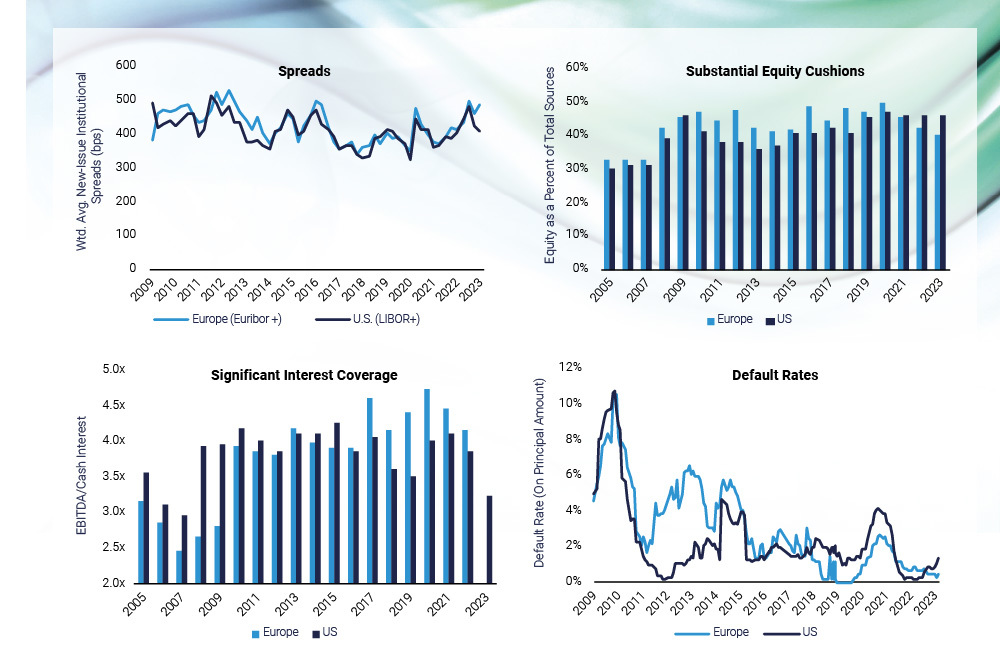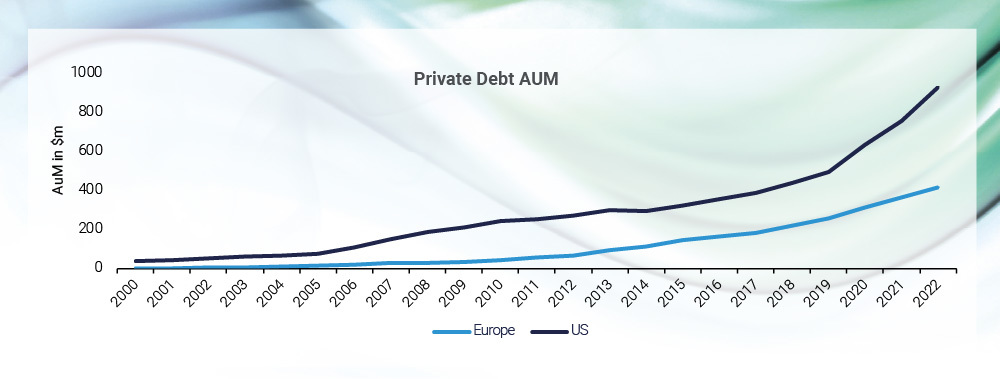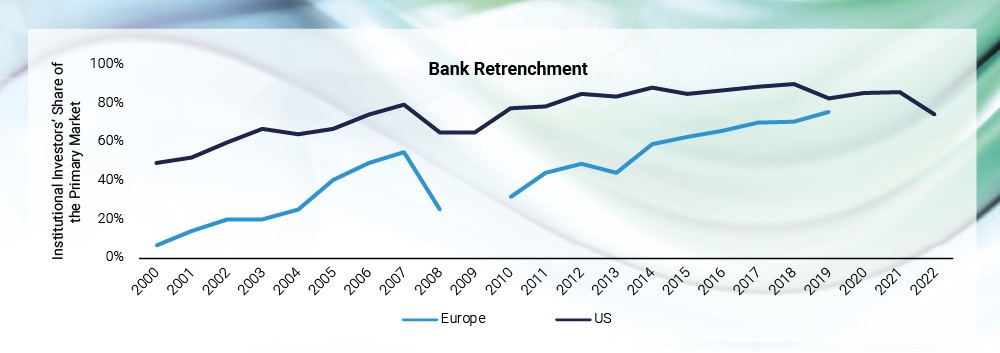Comparing the US vs. Europe
The US private debt market and European private debt market offer comparable performance on key metrics such as spreads, equity cushions, interest coverage and defaults; tracking each other’s movements over the peaks and troughs of the credit cycle. However, a closer look at the nuances of each market reveals a number of key differences between the two. An understanding of these differences is critical for any investor looking prospectively at the two investment opportunities, and an experienced manager can seize opportunities in the European market.
Trends across the Two Markets1
As shown below, the US and European private debt markets have historically provided similar spreads and seen similar default rates, with some peaks and troughs. Both markets have been broadly similar in recent years in terms of the credit characteristics of the underlying companies, with equity cushions and interest coverage increasing since the Great Financial Crisis (“GFC”) in 2008/2009. The European market has a history of more conservative equity cushions, particularly from 2010 – 2019, with the markets converging in recent years. Lately, Europe has demonstrated attractive spreads and higher interest coverage while maintaining lower defaults.

Market Differences: European Private Debt Opportunity
That being said, there are a few key differences between the US and Europe that private credit managers with experience in Europe can take advantage of, which benefit origination and offer downside protection.
The European private credit market is less mature in size, depth and competitiveness as compared to the US. This offers more favourable origination opportunities in Europe for managers with expertise in the local jurisdictions. As shown by the below private debt AUM chart2, European private debt AUM lags below the US with room to grow.

Whilst the European market is smaller than the US, attractive supply and demand characteristics in Europe support further market growth. As shown in the below bank retrenchment data3, European non-bank institutional investors have continued since the GFC to take market share from banks which are limited in lending capacity by European regulation. However, US bank retrenchment has not grown in the same way in recent years, suggesting limited opportunity for further private debt growth.
In addition, there are fewer European non-bank lending alternatives compared to the US. For example, the US high yield bond market exceeds Europe in terms of the size, number and variety of institutional investors, providing more reliable capital to larger issuers. There are other non-bank lending alternatives in the US in addition to the high yield bond market, such as Business Development Companies and private placement regimes. These market dynamics suggest that European bank retrenchment has space to continue, providing opportunity for direct lenders.

A third difference between the two markets is that experienced European managers have more room for favourable outcomes in bankruptcies. The European markets lack a US Chapter 11 bankruptcy process and are subject to different enforcement regimes with varying degrees of lender-friendly characteristics. Lending across the different European countries requires more expertise and can be more complex than lending in the one country, like the US. However, a successful outcome for a European company is more likely due to collaboration between all parties involved, in comparison to Chapter 11 processes in the US. Managers with European restructuring experience can navigate this complexity and benefit from a more collaborative workout situation. This offers downside protection and benefits returns as ultimately, a debt manager’s alpha stems from its ability to avoid defaults and minimise losses.
The Attractiveness of European Private Debt to Limited Partners
When a Limited Partner (“LP”) invests in a manager that can take advantage of the opportunities outlined above, there can be additional benefits to their portfolio.
Firstly, LPs investing in European private debt gain exposure to a key global economic market, supporting a well-diversified portfolio. In addition, European upper mid-market companies are cross-border, largely global firms with geographically diversified revenue streams, which provides more downside protection (exposure varies across multiple countries, each with its own economy, consumer preferences, business environment). Direct lenders’ portfolios often have exposure to multiple companies in industries across Western Europe and beyond. In comparison, US equivalent-sized companies are typically local enterprises thus offering less opportunity for diversification, notably against global shocks.
Unlocking these opportunities requires deep relationships and specific expertise in individual markets for successful origination. Such expertise can be delivered by managers who have navigated multiple credit cycles in Europe
Footnotes
1 Past performance is not a guarantee of future results.
Source: LCD, Global Leveraged Lending Report and Quarterly European Leveraged Lending Review, both as at Q1 2023. For illustrative purposes only and subject to change. Past performance is not a guarantee of future performance.
2 Source: Preqin.
3 Past performance is not a guarantee of future results.
Source: LCD, Global Leveraged Lending Report, as at Q1 2023. For illustrative purposes only and subject to change. Past performance is not a guarantee of future performance. LCD did not track enough European observations in 2009 to compile a meaningful sample. Given the lack of primary issuance in Europe, LCD did not track enough observations to compile a meaningful sample for 2020 and LTM 2021. As a result, the primary market investor charts are not updated for 2020.




